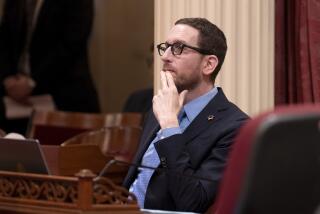Recognizing a Good Record
So far there have been more threats made than practical solutions offered in the dispute between federal and state officials over improving California’s Smog-Check system. But now there’s new legislation pending before the state Senate that could strike a sensible compromise by maintaining convenience for motorists without sacrificing air quality.
The bill, SB 629, sponsored by Sen. Newton R. Russell (R-Glendale) and Assemblyman Richard Katz (D-Sylmar), preserves a decentralized Smog-Check system while imposing stricter emissions standards on autos and enforcement checks on stations, technicians and motorists. It also takes aim at grossly polluting vehicles.
But even if approved, the bill could run into trouble with the Clinton Administration, displeased with a decentralized Smog-Check network that it considers outdated and vulnerable to fraud. EPA Administrator Carol M. Browner has even threatened to withhold more than $600 million in federal highway funds unless the state adopts a centralized system that would rely on 200 government-contracted testing facilities. That hasn’t gone over well with state leaders like Gov. Pete Wilson and Speaker Willie Brown, who are warning President Clinton that a lack of flexibility in getting smog checks could cause huge headaches for Californians--and for politicians who might be targets of their frustration in future elections.
SB 629 would preserve the state’s existing network of 9,600 local, privately operated Smog-Check stations. But it would require Smog-Check facilities to upgrade their testing equipment to monitor vehicle emissions during a simulated driving cycle. The bill also increases civil penalties for those found guilty of trying to defraud the system.
Remote-sensing equipment would be placed on freeways and roads in the most polluted areas, including Los Angeles, Orange, San Diego, San Bernardino, Riverside and Ventura counties, to determine whether pollution is indeed reduced under the revised state system.
The EPA would be wise to let California try this system before coming down on the state so hard. From 1980 to 1992 the state cut airborne pollutants by 50%; in Los Angeles the number of smog alerts fell from 101 to 41 in the same period. That good record should be recognized. California has earned a chance to prove itself again.
More to Read
Sign up for Essential California
The most important California stories and recommendations in your inbox every morning.
You may occasionally receive promotional content from the Los Angeles Times.










